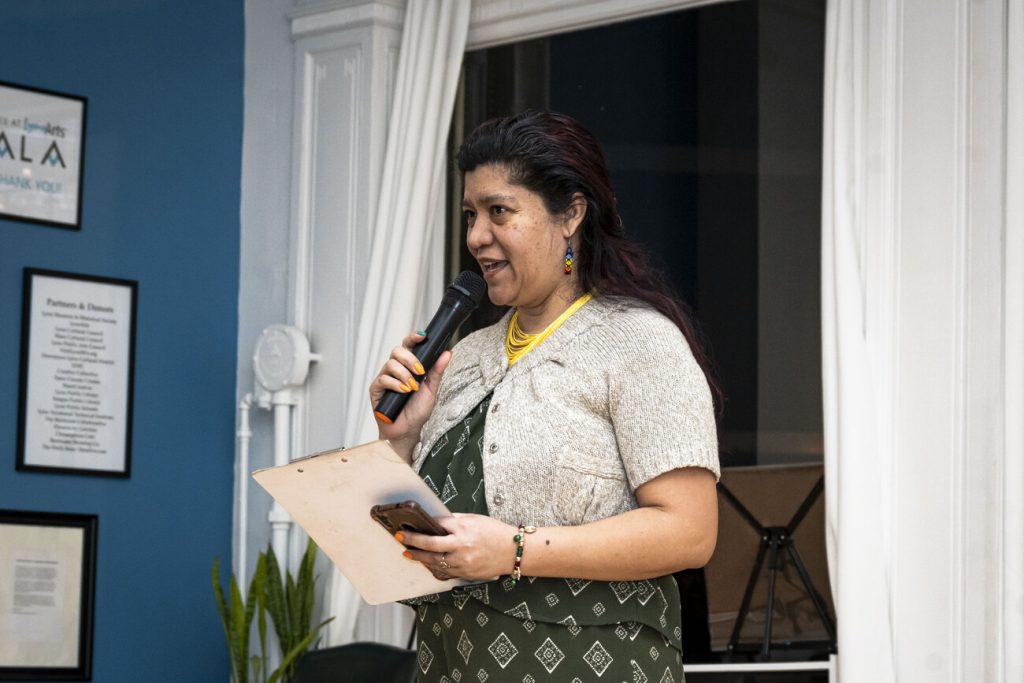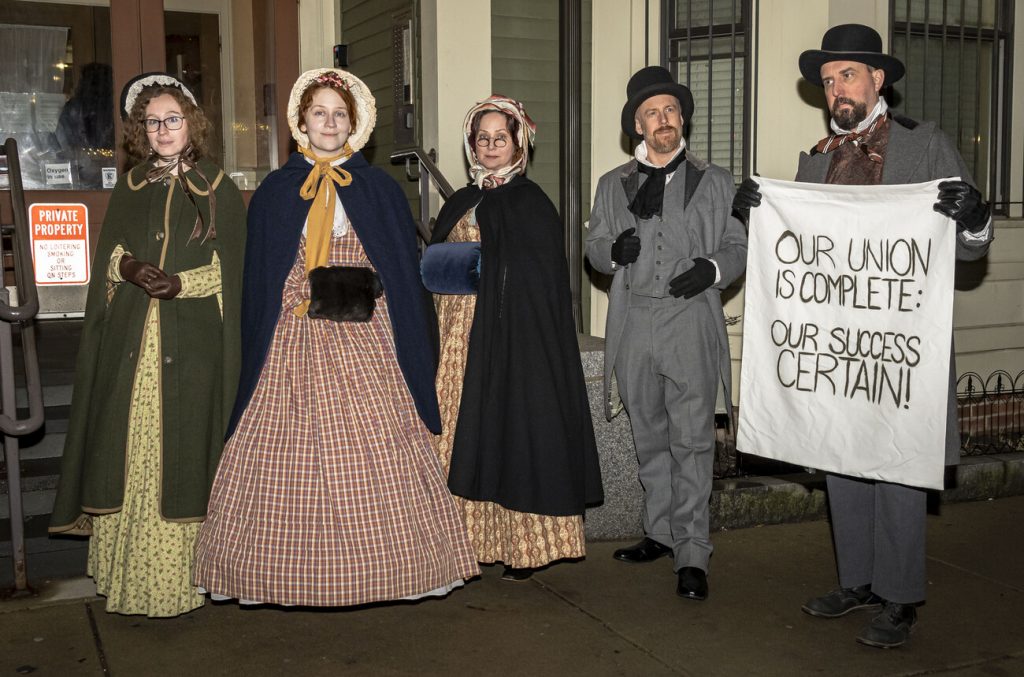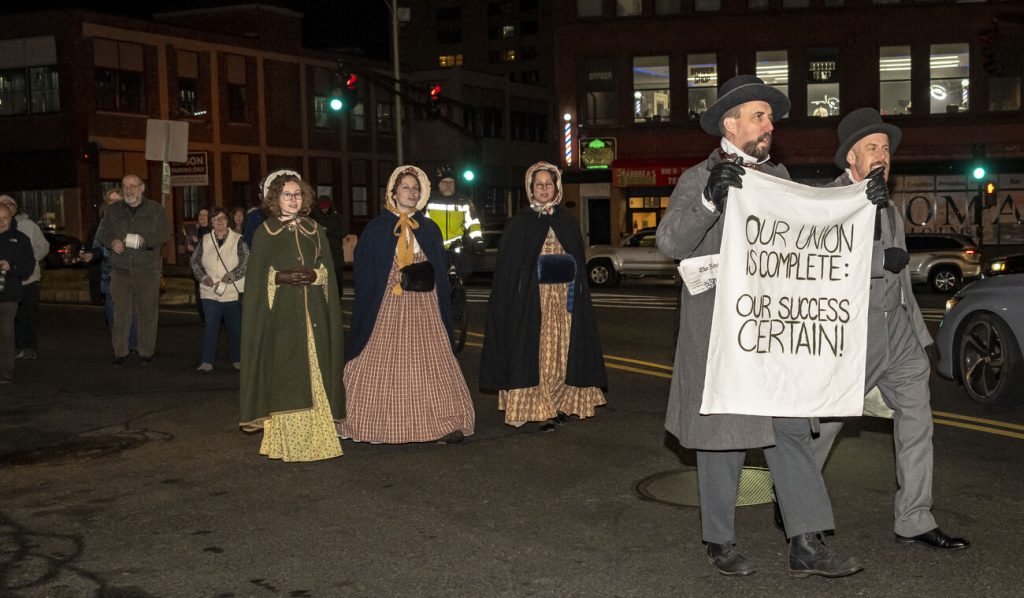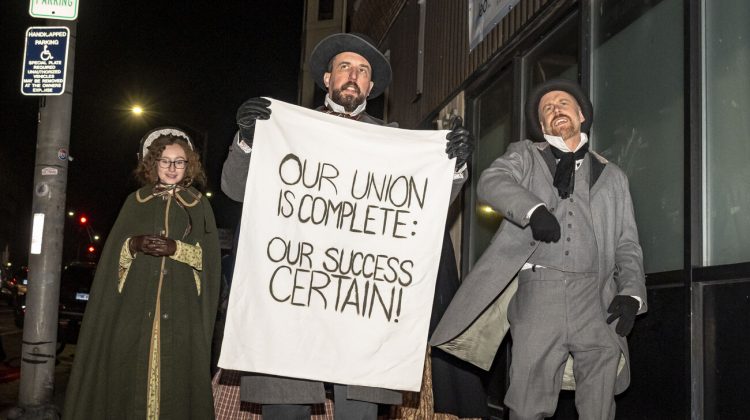LYNN — The 1860 shoemakers’ strike came to life through a reenactment and symbolic walk that began at the Washington Square Residence and concluded at the Galleries at LynnArts on Friday.
A commemorative walk portraying the iconic strike was followed by a reenactment at LynnArts. Attendees were able to relive the strike with the cast of History Alive from Salem in an interactive experience.
The event was a partnership between Lynn Walking Shoe Tours and History Alive. Lynn Walking Shoe Tours founder and Tour Guide Michelle Guzman organized the evening’s events.

History Alive President and Artistic Director Kristina Wacome Stevick said the reenactment was a great fit for her organization.
“History Alive makes original theater out of local history and we’re particularly interested in social justice and theater that incorporates the audience into a larger piece, so it kind of ticked all the boxes for us,” Stevick said.
The cast from History Alive included Jennifer Emerson, Isabella Walsh, Melinda Kalanzis, Lucas Milliken, and Jonathan Streff. Milliken and Streff played the roles of supportive men in the strike. Emerson played a married woman with a family, Walsh played an unmarried second-generation immigrant, and Kalanzis played the role of a recent Irish immigrant. The reenactment was directed by Samantha Searles.

Actors began marching down Broad Street chanting “strike” with attendees following behind them, then took a turn down Exchange Street before arriving at LynnArts.
The reenactment was narrated by Marjorie Crosby, a mentor and retired teacher, who opened it with a question.
“Did you know Lynn was a pioneer and advocate to stop child labor?” Crosby asked. “For 16-hour days men earned $3 a week and women only $1. It wasn’t enough to support a family, let alone repay debt. Besides shoemaking, Lynn was also known for being the pioneer in social-justice movements and also in organized labor.”
Crosby said employers were unwilling to meet with workers at the time, but workers in Lynn took matters into their own hands. Crosby said the shoemakers’ strike began with 3,000 Lynn workers who deliberately chose to start their rebellion and strike on George Washington’s birthday. She added that strikers traveled to Marblehead, Newburyport, and Haverhill.
“This winter past, we’ve kept alive by toiling at night, with no encouragement to thrive, such unpaid toil ain’t right,” the audience and cast sang together.
“I am wary of the agitated and excited state of this community,” Emerson said during the reenactment, playing a character opposed to the strike. “With all these workers out of commission, Lynn hasn’t long before businesses fold completely.”
“My mother says the same thing to me when I tell her about the striking workers. She says, ‘Kate, your papa and I when we first came here did not have the luxury of speaking sharply to bosses,’” Kalanzis said, playing the role of an unmarried woman in favor of the strike.

A sign held by Streff read, “Our union is complete: our success certain!”
“All of Lynn is on our side,” Streff said in character. “This will be the greatest and largest strike in all of New England.”
Crosby said the strike for a living wage was a partial victory. The strike spread to 25 New England shoe towns and 20,000 shoe workers walked off the job, while another 20,000 supporters marched in parades.
“It was a collaborative action coming from different angles. By the second week of the shoemakers’ strike, employers were ready to raise wages,” Crosby said.
Dr. Sheryl Ollie, who moved to Lynn from Detroit in 1995, attended the walk and reenactment. Detroit, the home of Henry Ford and the Ford Motor Company, had many similar strikes, she said.
“That’s what attracted me to Lynn, because it reminded me very much of my growing up,” Ollie said. “I lived centrally in Dearborn, Mich., which is where all the factories were.”

